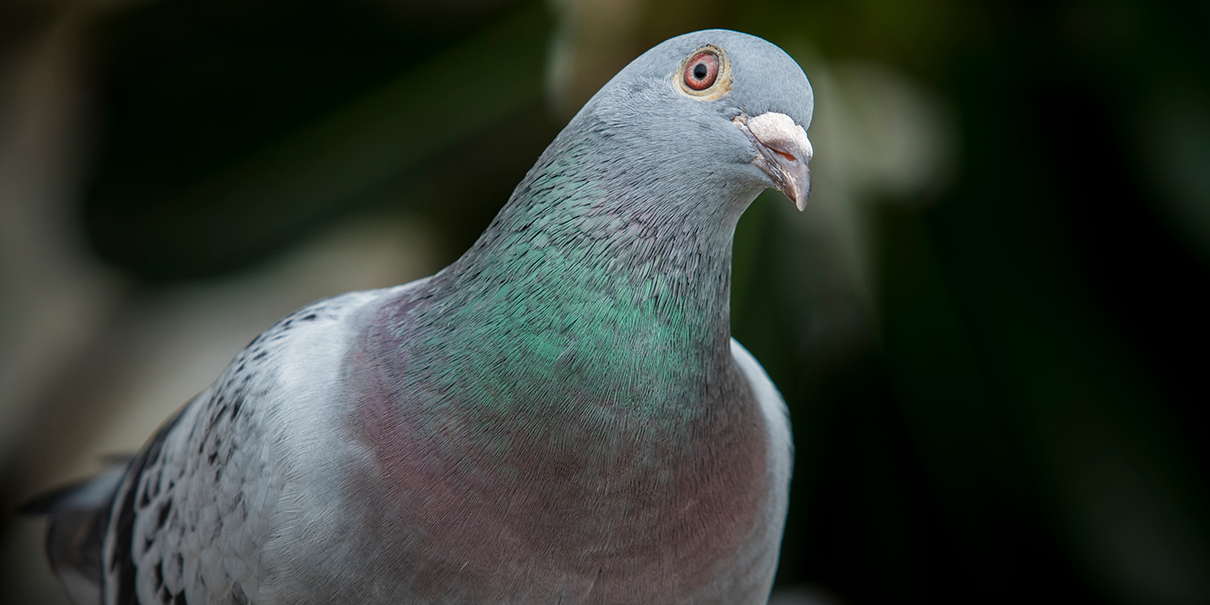
Amazing Facts About Pigeons
General Advice
Fun
Bird
01/05/2023
Take a closer look at those ubiquitous pigeons waddling under your feet in a city centre or cooing from the rooftop – they are man’s oldest feathered friends.
The humble pigeon isn’t just a tourist spectacle in famous city squares – they helped build ancient civilizations; are among our most decorated war heroes; and their flying prowess and sharp homing instincts thrill the hearts of pigeon lovers the world over.
Fanciers’ roll of honour
Someone who keeps pigeons is called a ‘pigeon fancier’. Although not obvious members of the pet-owning community, fanciers come in very large numbers, and thousands of pigeon-racing clubs exist all over the world. Belgium is regarded as the home of pigeon racing, with 60,000 registered fanciers in a nation of 10 million. But nearly every country you can name has a club of some description. In New Zealand, there are 45 pigeon clubs with a collective membership of more than 450, and that doesn’t include hundreds more who simply keep pigeons and doves as pets.
Geoff Stowell, of Pigeon Racing New Zealand, says the sport gets into your blood. It’s the excitement of watching your birds returning home, the elation of a win, and the challenge to do it again by breeding a future champion, he says. It’s also the fraternity of friends you make among the way. If you feel this buzz, then you are in good company. Famous folks who are proud to be called pigeon fanciers include royalty and celebrities. Queen Elizabeth II is the patron of the Royal Pigeon Racing Association in Britain and has her own royal lofts. Mike Tyson fancies pigeons, after picking up the bug from his mentor and trainer, Cus De Amatto. Elvis Presley loved pigeons and so did tough-guy actors Marlon Brando and Lee Marvin.
Pablo Picasso held pigeons in such high regard that he named his daughter Paloma (Spanish for pigeon or dove). And renowned fashion designer Maurizo Gucci once paid more than US$10,000 for an American show bird.
Interesting things about pigeons
Pigeons possess extraordinary navigation abilities and can sense the earth’s magnetic field, which is surprising since they are not a migratory species. Young birds are raced short distances of 160 to 500km, while birds over a year old race up to 1000km, reaching speeds of 150kph. They can cover this distance in a day. At a maximum of seven years, a pigeon’s racing life is not a long one, although birds can have a lifespan of 20 years, if they are lucky. Common dangers racing birds can run into include foul weather (they can’t fly through fog), power lines, tree limbs and hawks.
The speed of a pigeon
Pigeons have recorded flights in excess of 2700km in racing competitions. Their average flying speed over moderate distances is 50kph, with bursts up to 100kph. They can see for distances of 40km, have an acute sense of smell, and can detect the earth’s magnetic fields. However, no one is completely sure how pigeons navigate so well over uncharted territory. Recent studies at Oxford University, where tiny satellite tracking devices and cameras were attached to racing pigeons, found that after a bird had flown a route a few times it simply followed local highways and railway lines in addition to using its natural solar and magnetic compass skills.
For a race, a number of pigeons are taken to a point and released at the same time. Each loft has a synchronized clock for timing every bird as it arrives home, thanks to a special ring placed on the bird’s leg. Upon its arrival at the loft, the ring is taken off the bird and placed into the clock to record its flight time, or the time is recorded automatically when the bird steps over an electronic plate. As each loft is a different distance from the starting point, the flight time and the distance is calculated to come up with the fastest, winning bird.
If you find a tame pigeon with an identification ring on its leg, you can take it to your local vet or bird rescue organisation. The first three letters on the bird’s identification ring are its club registration. If you visit the Pigeon Racing website www.prnz.org.nz they have a page on how to care for found pigeons and can reunite them with their owners.
Purchasing a pricey bird
Overseas, a champion racing pigeon can fetch US$10,000, while in New Zealand a top breeding bird sold at auction is more likely to fetch just under $1000. The record price paid for a pigeon is US$185,000 20 years ago for a British champ called Invincible Spirit. There’s big money to be won in pigeon racing in some countries, and testing winners for performance-enhancing drugs is now common in Europe. In Taiwan, with its 500,000 fanciers, 150 racing associations, and millions of dollars in prize monies at stake, bird-napping for ransom money is so common that some owners have elaborate security systems, or 24-hour armed guards looking after the champs in their lofts.
Pigeon ancestry
The common city pigeon is directly related to the feral Rock Dove (Columba livia), which still lives in the wild on the coastal cliffs of Western and Southern Europe, North Africa and Southwest Asia.
Rock Doves have been domesticated for thousands of years, and these hand-reared birds (usually referred to as city pigeons), find the ledges of high buildings a perfect substitute for sea cliffs. Residential flocks of them are now famous fixtures in city centres such as Trafalgar Square in London; Dam Square in Amsterdam; and Piazza San Marco in Venice.
Selective breeding of birds with acute homing skills has resulted in the modern Homing Pigeon, which is used for pigeon racing. The Carrier Pigeon, despite the name, are lousy flyers and are kept for their unusual looks as ornamentals.
Building empires
The great empires of Carthage, Egypt, Rome and China set up vast communication networks to keep their emperors in touch with remote areas at a time when horse and riders, or caravans, would take weeks to deliver the same information.
During the 17th and 18th centuries, pigeons relayed messages for European stockbrokers. It was thanks to one of these birds that the Rothschild banking dynasty increased its vast fortunes in 1815 when it learnt, before other financial houses, that Napoleon had been defeated at Waterloo. In 1850, Paul Reuter founded the news service that still carries his name, with 45 pigeons that delivered news and stock prices between Brussels and Aachen.
Closer to home, the Great Barrier Pigeon-gram – the world’s first official airmail service – was set up in 1898 to deliver shopping lists, election results, and hotel bookings between the Hauraki Gulf island and Auckland. The service was replaced in 1908 when telegram cable was laid to the island, but was revived in 1993 as a tourism interest. Messages bearing a special stamp were pigeon-posted to a bird fancier in Auckland who than mailed the message on through conventional post. The service drew interest from all over the world (especially from stamp collectors), but ceased in 2003 when the ferry service, which delivered the birds, to Great Barrier, stopped.
Did you know? Pigeons are war heroes
The humble pigeon has seen its share of front-line action over centuries of wars, and it counts among the most-decorated animal war heroes.
During the 1871 Franco-Prussian War, Paris was besieged by Prussian troops for four months. This was the first time micro-photographs, glued to the wing feathers, were used to carry thousands of messages over the heads of the Prussians, taking news and information to friends as far away as London. One bird made the journey six times, earning it the title ‘angel of the siege’. Other pigeon war heroes include a Black Check cock called Cher Ami (French for ‘dear friend’) used by the US Army Signal Corps in France during the WWI (1914-18), and awarded the French Croix de Guerre. The bird’s final mission in October 1918 saved around 200 American soldiers who were lost behind enemy lines. Shot through the breast and missing a leg, Cher Ami delivered their call for help in a capsule found barely hanging from a ligament. The bird died the following year and was enshrined (on one leg) in the Smithsonian Institution.
During WWII (1939-45), 32 pigeons were awarded the Dickin Medal, recognised as the animal equivalent of the Victoria Cross. The first animal outside of the British Commonwealth to receive this award was a bird called G.I. Joe. This US Army carrier pigeon was sent on a do-or-die mission on 18 October 1943 to stop allied planes bombing British troops who had unexpectedly advanced into enemy territory. Joe flew 32km in 22 minutes, arriving with his vital message as the bomber’s engines were warming up.
Pigeons or doves?
The pigeon is one of the 308 species of doves known as Columbiformes. The terms ‘dove’ and ‘pigeon’ have become interchangeable over the years, although smaller species are more likely to be called doves. Only in Holland is the homing pigeon correctly called a postduiven or messenger-dove.
In common, pigeons and doves are stout-bodied birds with short necks and short slender bills. They make poorly constructed nests of sticks and produce two white eggs incubated by both sexes. Unlike most other birds, doves and pigeons produce ‘crop milk’ for their young, which are called squabs. They are fast breeders, with the squabs going from hatched egg to out of the nest in just 21 days.

Written by The Pet.co.nz
Team
Written by The Pet.co.nz Team
A team of specialists with backgrounds in animal nursing, animal care, and all things pet related.